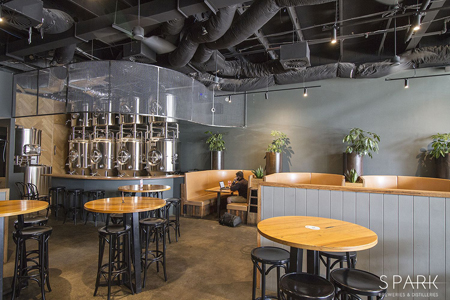Australian craft and the brewpub phenomenon September 2018
As the Australian craft beer market becomes more crowded, the brewpub is becoming an increasingly attractive business model.
The Australian Tax Office says that there are now 548 active licences to manufacture beer in Australia, with the growth driven by changing tastes.

The Spark brewhouse at Melbourne’s Burnley Brewing
While industry research firm IBISWorld reports that “the fragmented nature of the industry has allowed many smaller breweries to grow and flourish over the past five years,” it cautions that “the market power of the two largest beer breweries in Australia is a concern for smaller less competitive craft breweries, especially those that compete against Lion and SAB Beverage (sic) to secure tap beer deals in pubs and bars”.
The report highlights that for small scale producers, being able to self-manage their distribution ensures they can maintain favourable pricing and quality control in an industry where reputation is everything.
For many Australian craft brewers, the brewpub provides owners with immediate cash flow and a consumer-facing platform providing valuable research and development insights.
Bart Watson, chief economist for the US Brewers Association told Brews News that the Australian beer market is going to see similar trends to the US.
“As the number of small brewers grows, creating a consumer connection becomes more important, and brewpubs can be one way to effectively showcase your brand, your beers, and create a memorable experience that leads to loyal customers in the future,” Watson explained.
While the brewpub model is unlikely to achieve the scale of distribution brewing, Watson said that it “will certainly be a viable – albeit smaller-scale – alternative for some brewers”.
Not only is the serve-on-site model “a powerful way to market and build brands as well as get rapid customer feedback on new innovations… it’s growing due to strong beer lover demand for an experience”.
“Finally, it’s part of a larger ‘third space’ trend toward occasions that don’t fit in the tradition on/off premise dichotomy.”
For the US craft beer sector, the rise of brewpubs has largely to do with legislative reform. Unlike in Australia, the brewpub model – what were referred to as tied houses – was made illegal in most States after Prohibition. These venues were said to unfairly undercut other retailers and distributors on price.
Until 1977 in the State of California, the serve on site model was eradicated in favour of a three-tier system that acted to separate producers from retailers by way of a distributor. Since 1989, 33 US States have passed laws to allow on premise beer sales – six States still do not allow them.
US academic Bryce Casavant, who wrote about How On Premise Beer Sales Affect Microbreweries last year, said that “Passing an on premise beer sales law leads to an immediate increase in the number of microbreweries and an eventual increase in microbrewery production”.
Casavant said that “profit margins”, “research and development” and the “brewery experience” are what stand to privilege the brewpub model in the eyes of brewery owners.
For brewing operations his size or below, owner of Sydney’s Sauce Brewing Co Mike Clarke said that the taproom is integral to the business.
“It’s a nice bit of cash flow to begin with and then it becomes your marketing, your public facing,” Clarke explained.
“When you’re first opening you need that taproom presence, people trying the beer and meeting the people that brew the beer.”
“If you don’t have a taproom and you’re only selling beer, you’ve got to focus on the sales and marketing so much more, and that’s on a different scale to where we sit.”
While Clarke doesn’t describe Sauce as a brewpub, he does admit that the microbrewery and taproom have created a strong local presence.
Founder of Byron Bay brewery Stone & Wood Jamie Cook, told Brews News that the brewpub model could be finding favour with smaller independents because they are finding it hard to get traction in the wholesale market.
“The guys who don’t have strong brands are finding it hard to get distribution,” he explained.
With many breweries buying pubs and pub groups buying breweries, not to mention the demand for taps by the likes of CUB and Lion, Cook said that the wholesale market is cluttered.
The Australian market has to some extent followed that of the US, where distribution is also crowded.
“There are a limited number of tap handles and shelf slots and distributors have thousands of brands to try to juggle. It’s hard to stand out in that environment,” Watson explained.
“It’s hard to make blanket statements about the US versus other countries since the rules are state-based, not Federally-based… but with a crowded market, small brewers will need new forms of market access.”
This article has been presented by Spark Breweries and Distilleries. Achieve your brewing ambition with Spark. Brewpub specialists, plus custom large scale Brewing and Distilling systems. Local consultation, engineering, long warranty backup and close support. Equipment finance available.
Enquire now.
Read more: How to start a brewing company: Part One.

